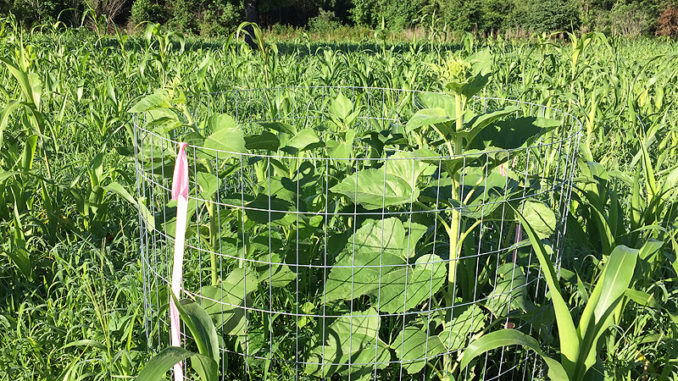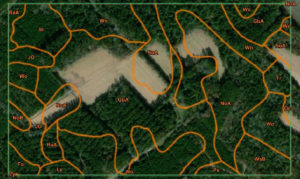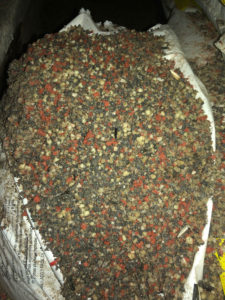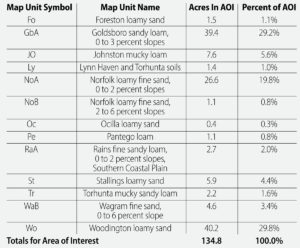
Get your goals, ideas for 2020 down on paper
February is a time for rest and relaxation after a long deer season in the Carolinas. Sleep-deprived hunters should take some time off from the woods and early morning rituals to gain some much-needed sleep and couch time.
And while reminiscing about the past season, hunters can review their logs and scribble out next season’s plans for food plots. The plan should include improvements to soil, weed control, seed selection and other activities for better results.
Planting food plots isn’t exactly rocket science. Anybody can grow a hearty crop with preferred conditions and all the right stuff. It’s basic chemistry. And plenty of planting guides are available that are tailored for every region of the country. But Mother Nature isn’t always cooperative. All food-plot players get to experience crop failure at some point.
Food-plot seeds and planting guides give great advice that can help get a good plot going. However, every site is different with respect to soil chemistry, drainage and overall suitability. Every season will provide a good education on what to change the next year and what to keep the same. A conscientious program will include a complete record of each manipulative activity and the conditions before, during and after.
Land managers need to identify the root cause of poor performance before they make any changes to the plan. Quite often, managers blame a problem on something different than the primary cause. They need to make sure they understand what went wrong before they make changes.
The pH factor
Unfortunately, failures are very possible when the soil pH isn’t suitable for the selected plants. On a chemical level, the soil pH controls certain reactions that can make fertilizer applications usable or non-usable for plants. An unsuitable soil pH is usually the root cause of most plot failures. And everything trickles down from there. In order to have thriving and attractive food plots, the basic ingredients must be combined. And it all starts with the soil pH. Acid-base correction should never be avoided. Test the soil in late January or early February before too many changes to the plot plan are developed.
Even though soil pH is the primary factor, other adjustments need attention too. Fertilizer timing, application rate and fertilizer mix can make a direct improvement on plant growth and sustainability.
The weed problem
Weed control is another big factor, especially in warm-season plots. Weeds can be super aggressive, outcompeting planted vegetation. Weed competition can be easily reduced by pre-plant herbicides, Round-up Ready seed with post-planting herbicides, and/or modifications in planting methods.
Planting methodology can make a major impact on the success of any food plot. Seed depth is the most critical. Seeds only need the minimum depth for germination. Beyond depth, the timing of planting around rain events can make a difference in productivity.
Finally, some of the warm-season crops — soybeans and sunflowers, for example — need protection during early growth. Deer will eradicate a planting of soybeans and sunflowers very quickly, months before its time. And while many plants can re-sprout after depredation, some can’t handle heavy browsing during the early stages of growth. Deer and turkeys showing up soon after planting can be exciting. But they can be very destructive, and many plots need plot-browsing protection months before the crops mature.
It’s not time to plant, but it is time to prepare
February sure isn’t the time to plant. But hunters can still devote time to food plots that will be some of the most-important hours they invest all year. Nature can sometimes ruin the results. But most food-plot failures result from poor decision-making early in the process. Poor weed control, failure to correct soil pH, nutrient deficiency, premature browsing, improper planting conditions or improper planting can singly or collectively create less-than-desired results.
If land managers are concerned about a cool-season, warm-season or 365-day plot program, planting logs and plan reviews are critical to perfect a plot. It’s time to review these activities and make adjustments where changes are needed. Any adjustment should always be reduced to writing. These log books will be responsible for remedying issues and producing the best food plots around.
Food plots can be costly, but spending money in the right places at the right times can make it all worth it in a deer stand when a 12-point buck walks out to feast on the tender vittles.
Use resources to locate new sites for food plots
 Many new food plots are placed by opportunity. Hunters identify an open area that can be accessed with a disk or tiller and gets enough sunlight to turn some seeds into a reliable food source. While many of these spots turn into good food-plot locations, it doesn’t always work as planned. For hunting, the most-productive plots are placed in areas that provide deer and other wildlife unencumbered feeding opportunities. But these areas need to also be located in the right soil, drainage class and location for adequate growth. When flexibility is available, these areas can be tailored under the right conditions to produce the best results.
Many new food plots are placed by opportunity. Hunters identify an open area that can be accessed with a disk or tiller and gets enough sunlight to turn some seeds into a reliable food source. While many of these spots turn into good food-plot locations, it doesn’t always work as planned. For hunting, the most-productive plots are placed in areas that provide deer and other wildlife unencumbered feeding opportunities. But these areas need to also be located in the right soil, drainage class and location for adequate growth. When flexibility is available, these areas can be tailored under the right conditions to produce the best results.
Luckily, a wealth of electronic resources on the internet provide land managers with the necessary tools to locate a new plot. In addition to online aerial photos and USGS Topography maps, the Natural Resource Conservation Service (NRCS) has published soil surveys for all counties of the United States over the last century. They can be downloaded as an Adobe PDF free of charge. The soil surveys provide the soil type with specific descriptions of each soil type that can help answer questions about suitability for a new plot.
NRCS offers free help
In addition to downloading these relic paper documents, the NRCS has a very unique website called the Web Soil Survey (WSS) (https://websoilsurvey.sc.egov.usda.gov/App/WebSoilSurvey.aspx). It provides the largest natural resource information system in the world. It allows the user to easily navigate to the property, draw an area-of-interest polygon and produce a customized soil map with no cost to the user. Additionally, the program provides soil characteristics, suitability summary, vegetative productivity rating, yield potential, etc., for each of the soils located within the specified area of interest or survey area.
The WSS is a valuable tool to use to learn about the soils on the site for future and existing food plots.
The importance of phosphorous

Phosphorus is one of the big three macronutrients — nitrogen, phosphorus and potassium — that plants require for growth and sustainability. It is the “P” in “NPK.” The phosphorus percentage is the middle number of a fertilizer treatment, like in the general purpose fertilizer 10-10-10.
Phosphorus is directly responsible for the protein synthesis in plants that is needed for cell division, tissue development and energy storage. Also, phosphorus promotes root growth that helps plants uptake water and nutrients from within the soil.
Luckily, many soils are high in elemental phosphorus, so costs associated with phosphorus amendments can be avoided. But it must be present in sufficient amounts for growth. Phosphorus deficiency can be identified by a darkening of mature plants and a slight yellowing in young plants similar to nitrogen deficiency.
Ironically, phosphorus is responsible for root growth and is also the origin where the phosphorus particles enter the plant’s vascular system. Planters must introduce it via the root system and in a soluble form.
Phosphorus occurs naturally in phosphate rock. It is always part of another elemental compound. It is rarely available in its pure form due to its explosive nature when in contact with air. Farmers and food plotters apply phosphate as triple super-phosphate (46-percent phosphorus) combined with an application of nitrogen or with a combination fertilizer containing nitrogen or as ammonium phosphate. Phosphate combined with ammonium allows the phosphorus to be soluble and available to plants. Food plotters also routinely combine phosphorus with nitrogen and potassium to form a general fertilizer mix.





